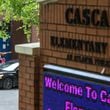I have run several pieces over the years by Jarod Apperson, who holds degrees in accounting and finance from NYU and does an excellent job dissecting education data. Now a doctoral student in economics at Georgia State University, Apperson has been a careful observer of Atlanta Public Schools.
Today, he explains why he's cautiously optimistic Superintendent Meria Carstarphen may succeed with her ambitious turnaround plan for the city schools.
By Jarod Apperson
Last night, the Atlanta Board of Education voted to approve a turnaround plan presented by Superintendent Meria Carstarphen. In doing so, they gave her the opportunity to take on something that has eluded school leaders around the country: the widespread improvement of struggling schools in an urban system.
Credit: Maureen Downey
Credit: Maureen Downey
The sad reality is that aside from marginal accomplishments superintendents can highlight, most leave districts largely in the same state they found them. This is not because most superintendents are bad but because the task is so daunting. A few years from now, we will know whether Carstarphen’s strategy has managed to break that reliable mold.
Some vocal community members have criticized Carstarphen's efforts including one who recently shared pessimism for the plan in a Get Schooled column. For a number of reasons laid out below, I am more optimistic about the plan's prospects, though I concede it will be an uphill climb.
High-dosage tutoring has proven particularly effective elsewhere
Of the 15 schools selected for targeted interventions, 10 will receive interventions managed by Atlanta Public Schools while five will be led by partner organizations. For the 10 led by APS, a central strategy in the plan involves additional resources that will be directed to providing students high-dosage tutoring.
In 2010, John Bates Clark Medal Winner Roland Fryer led a team attempting to turn around 20 schools in Houston, Texas. Early results from the experiment suggest it has been one of the few success stories in turnaround work, raising elementary math achievement by 0.18 standard deviations, enough to close the Houston's racial achievement gap in three years if sustained.
By implementing high-dosage tutoring in some grades and schools but not others, Fryer was able to isolate the impact of the strategy and found it to be particularly effective in raising achievement. Small groups were central to the tutoring approach that consisted of one hour a day for each student. Elementary students were tutored 3-to-1 and middle school students were tutored 2-to-1.
Should Atlanta’s tutoring approach meet equal success, we won’t have to wait long to see the target schools improve.
The plan tackles Atlanta’s leadership talent deficit
With so many small schools to manage, APS has long struggled to ensure that each campus has an excellent principal at the helm. While some schools have attracted transformational leaders, others have not. In the past, I have been critical of what sometimes has felt like settling for what’s available when hiring leadership talent.
Carstarphen’s plan takes two important steps toward improving school leadership. First, the plan reduces the number of great leaders the district must find by seven. With five schools led by partner organizations and two schools consolidating, the district will have an opportunity to shuffle its best leaders and give them the chance to impact more students. Carstarphen has already given consideration to this and when rolling out the consolidation plan, she announced school leadership at the same time.
Second, 10 school leaders will be supported by Rensselaerville Institute's School Turnaround Program. I was not familiar with the organization prior to the release of this plan, but I am glad that Carstarphen included a component focused on supporting turnaround principals. While I'm not aware of a studying evaluating the Institute's effectiveness with the level of rigor used in the Fryer's work above, their website points to substantial achievement gains at 15 schools they have partnered with in the past.
Should 10 Atlanta schools see similar results, it would move the needle.
Purpose Built Schools and Kindezi have had success with the students they teach
Four schools will be led through a partnership with Purpose Built Schools, and one school will be led by the Kindezi Schools (disclosure: I previously served as board treasurer for the Kindezi Schools).
Purpose Built Schools looks to replicate the Drew Charter School model while Kindezi plans to replicate its West Lake and Old Fourth Ward schools, with a focus on small class sizes.
Drew Charter School and Kindezi have both demonstrated an ability to raise student achievement for the students they have served. According to an analysis published by APS, both consistently exceed achievement of schools with similar levels of poverty. Further, the State Charter Schools Commission's annual analysis from the past two years shows the schools' students have been progressing faster than the state average. Drew and Kindezi students on average grew at annual rates of 0.06 and 0.14 standard deviations above the state, respectively.[1]
If the partners were able to replicate these results, Carver Cluster schools would be dramatically improved in a few years.
Success will be an uphill climb
To be sure, none of these strategies are foolproof. Even though there are reasons to be hopeful, there are also reasons to question the prospects for success.
Will tutors hired by APS be of comparable quality to those in the Houston study? Will APS dedicate sufficient resources to keep the dosage of tutoring high and the tutor-student ratio low? If the reality of implementation falls short of the vision, results may not match what was achieved in Houston.
Will APS be able to get turnaround principals what they need to improve schools, including consistently high-quality teachers? If not, even great principals will find themselves frustrated and struggling to make real progress.
Will Purpose Built Schools and Kindezi be able to translate their success as mixed-income charter schools to a more challenging student body? Drew has succeeded as a school where about 40 percent of students are low income.[2] How will the model hold up when faced with the 93 percent low-income students at Thomasville?
Kindezi has succeeded in a context where 44 percent of students are low income. Will it work at Gideons where 88 percent of students are low income? If the models are in part reliant on having a mixed-income student population, the partners’ turnaround efforts may not mirror their charter school success.
These questions will not be answered today or even this year. It will take time for the district to look back and assess progress. If a few years from now, we see a system that looks largely like it does today, many will conclude Carstarphen has failed. I will be slightly more generous and conclude that her ambitions ran into the unfortunate reality faced by district leaders across the country: turning around a district is a rare feat.
If, however, we look back a few years from now and see this plan as a turning point for struggling schools, the city of Atlanta will owe Carstarphen a great debt of gratitude for the courage it took to put forth a plan that has drawn the ire of some. She could have taken the easy route, adding a couple of professional development days in the summer, and avoiding any strategies that might be met with skepticism. Instead, she put forth a plan she thinks has the best chance to succeed, placing students above scoring political points.
It will take time for us to know whether Carstarphen’s courage pays dividends. I think it might.
[1] This is the simple average of the subject / school-level combination results from the second model in the technical appendix across both years.
[2] Numbers based on APS challenge index which in large part reflects participation in TANF and other similar programs.
About the Author







